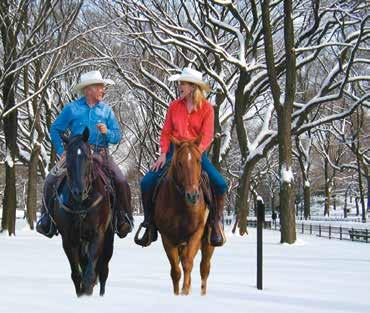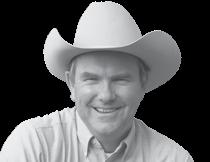Wyoming Livestock Roundup • Volume 32 No. 32 • December 5, 2020
WEEDS continued from page 1 “Some seeds, not necessarily mullein, can be viable in the soil for up to 50 years or longer, so this kind of issue takes a long time to get a hold of and manage,” Lawrence notes. “After mullein germinates, it spends the rest of the first year in a vegetative growth form and doesn’t produce seeds. It dies down to the crown in the winter and comes back the next spring, producing flower structures with seeds.”
The life cycle and trademark velvety, soft leaves of mullein make it a difficult plant to eradicate with herbicide. However, Lawrence and Stephenson have conducted research to find which herbicide products and application times work best to control the weed. Mullein control After testing seven different herbicide products, along with an added crop oil concentrate to penetrate the fuzzy leaves, the
ANGUS continued from page 1 Oct. 27, Retallick noted, “Getting cows pregnant is one of the main drivers of economic sustainability in the beef industry. In fact, in 2018, the Beef Site reported a loss of $1.6 billion in revenue due to infertility.” “Because we know fertility is of the utmost importance to our Angus breeders, we went a step further in our research to understand haplotypes affecting fertility in Angus herds,” she continued. Understanding haplotypes During the October webinar, Retallick was joined by AGI’s Research Geneticist Dr. Duc Lu, who has spent several years looking into haplotype patterns in the AAA’s genomic database. “A haplotype is a string of consecutive alleles – a minimum of two and a maximum of the length of the chromosome – on the same DNA strand and tend to be inherited together,” Lu explained. “If a haplotype is identical, it is considered homozygous in that particular region, and if the haplotypes on each DNA strand are different, they are considered heterozygous.” Lu noted he found a handful of haplotypes in the database, which behave similarly to the recessive mode of inheritance. He further noted
these haplotypes occur at a range of different frequencies, from around one to five percent in the population. Haplotypes versus genetic conditions Retallick noted there are a few glaring differences between haplotypes and genetic conditions. “Genetic conditions involve an individual genetic mutation. This may be a specific insertion, deletion or change in variation of the genes,” she explained. “Another difference we have identified is genetic mutations occur at much higher frequencies, around 15 percent.” Additionally, Retallick explained many genetic conditions are lethal, therefore they have a greater financial impact on cowherds. “Lu’s research basically identifies a haplotype pattern associated with a phenotype. He isn’t identifying a causative mutation,” she stated. Future opportunity for Angus breeders While AGI and AAA are still in the thick of their haplotype research, Retallick noted the end goal is to ultimately provide a new breeding management tool for Angus breeders. “There are a few things we hope to accomplish as we move forward,” she said. “First, we want to leverage this unique information for our Angus breeders.”
duo found all of the herbicides used to be effective in controlling mullein. “In our study, we found everything we used, including 2-4,D and dicamba, which are not labeled for mullein control, worked,” shares Lawrence. “However, all herbicides labeled for use on common mullein specify the best timing of herbicide application is before the plant bolts and sets seed.” Lawrence shares the timing of herbicide application is often more important than the product itself. He recommends applying herbicide in the spring “A lot of other beef breeds and individuals in the industry aren’t in the position to do this,” Retallick explained. “Because AAA members have been so great about buying into new technology and genomic testing, we are able to leverage the Angus genotype database and address this issue before the frequency gets even higher.” “Next, we need to identify haplotype regions of interest with real phenotypic data, and the type of data we are looking at is currently focused on fertility,” she added. “We also need to make all of this information available to our breeders so they can make breeding decisions around these nuances in the population, which will ultimately decrease the frequency of identified haplotypes.” In order to accomplish these things, Retallick noted AGI and AAA need the continued help of Angus breeders. “While I appreciate the fact our members have sent in over 100,000 records of heifer pregnancy, it isn’t powerful enough for us to track these patterns in the overall population,” she said. “We need members to continue sending us complete and detailed breeding records.” Hannah Bugas is the managing editor of the Wyoming Livestock Roundup. Send comments on this article to roundup@wylr.net.
9
while the plant has ample water supply and before it goes to seed. “If producers miss the spring herbicide application, the next best time is the fall before any hard freezes,” he adds. “Although, a fall application won’t control any plants in the second year of growth, especially those which have set seed.” Another consideration for those looking to control mullein or any weed chemically, is herbicides work best when targeted plants are healthy, says Lawrence. Plants readily absorb herbicide in the spring, but after summer heat and water stress, plants take up less water so herbicides will be less effective. Cheatgrass control “Grazing has been recommended as a control option for cheatgrass,” says Lawrence. “In my opinion, producers aren’t going to eliminate cheatgrass through grazing, but they can reduce seed production, and if grazed during the right time of year, cheatgrass can be good forage.”
Celebrating 100 years in Wyoming BOOTS • HATS • BELTS • JEWELRY • COATS VESTS • DECOR • SHIRTS
Call Cruise Vacations toll free 1�855�530�0131 Visit � Clear Out West.com –OR– Cruise�Vacations.ca for more details.
Rejuvra is also a product safe for use on rangelands and grazed lands, notes Lawrence. A similar product, Esplanade, is marketed for industrial applications but has not been approved for range and pasture. Lawrence also shares Rejuvra could be an option for restoring desirable plant populations on rangelands. While there are economics to take into consideration, the cost of Rejuvra might not be an option for most producers. “Will removing cheatgrass from a pasture pay for greater production, more cattle per acre or better yields? Probably not,” says Lawrence. “There is evidence reducing cheatgrass will reduce wildfire risk, lead to more diverse plant communities and impact land value.” For both species, Lawrence shares he and Stephenson plan to continue weed management research to help growers. Averi Hales is the editor of the Wyoming Livestock Roundup. Send comments on this article to roundup@wylr.net. STOCK GROWERS ONLY WITH THIS AD
20%OFF ALL MEN’S & LADIES BOOTS & HATS
MADE IN THE USA
In Stock Only Expires 12/12/2020
PHOTO CREDIT: ROSS HECOX
Round Up A Western Christmas!
IT PAYS TO ADVERTISE J & E Inc. jneirrigation.com 405 South 3rd St. Basin, WY (307) 568-3646
November 5 to 16, 2021
In terms of herbicides to control cheatgrass, Lawrence says two herbicides have been used effectively for years. Rimsulfuron and imazapic both have good activity on cheatgrass, typically controlling around 90 percent of cheatgrass. But, they can injure desirable grasses and the control is variable from year to year. “There is a new product called Rejuvra, made by Bayer,” Lawrence notes. “It doesn’t work like a traditional cheatgrass herbicide, and it has no control over cheatgrass once it is germinated. But, it controls cheatgrass as it germinates and emerges from the soil.” Lawrence explains most cheatgrass seeds are viable in soils for up to two years, and Rejuvra applications have seen up to two years of cheatgrass control. “It is hard to get out in a time where cheatgrass isn’t up, so often Rejuvra will have to be mixed with rimsulfuron, imazapic or glyphosate,” he says. “These combinations lead to residual control.”
WE SHIP • FREE GIFT WRAPPING
SPECIAL HOLIDAY HOURS
Boots Sizes 6-15 Width A to EEE



